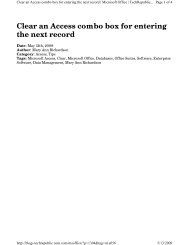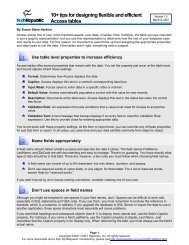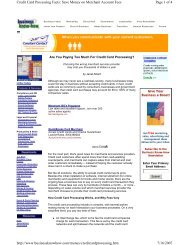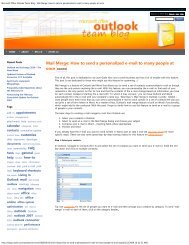McKinsey Quarterly: The Onl... - Cornerstone Business Solutions
McKinsey Quarterly: The Onl... - Cornerstone Business Solutions
McKinsey Quarterly: The Onl... - Cornerstone Business Solutions
Create successful ePaper yourself
Turn your PDF publications into a flip-book with our unique Google optimized e-Paper software.
<strong>McKinsey</strong> <strong>Quarterly</strong>: <strong>The</strong> <strong>Onl</strong>ine Journal of <strong>McKinsey</strong> & Company<br />
https://www.mckinseyquarterly.com/article_print.aspxL2=18&L3=31&a...<br />
4 of 5 11/6/2009 9:15 PM<br />
materials company—“they make people feel valued during these difficult<br />
times.” By contrast, our survey’s respondents rated large-scale<br />
communications events, such as the town hall meetings common during<br />
the economic crisis, as one of the least effective nonfinancial motivators,<br />
along with unpaid or partially paid leave, training programs, and flexible<br />
work arrangements. While communication is critical, attempts to convey<br />
messages about the state of the business often have some spin, one HR<br />
director told us.<br />
A chance to lead projects is a motivator that only half of the companies in<br />
our survey use frequently, although this is a particularly powerful way of<br />
inspiring employees to make a strong contribution at a challenging time.<br />
Such opportunities also develop their leadership capabilities, with<br />
long-term benefits for the organization. One HR director in the basicmaterials<br />
industry explained that involvement in special projects “makes<br />
people feel like they’re part of the answer—and part of the company’s<br />
future.” A leading company from the beverages industry, for example,<br />
selected 30 high-potential managers to participate in a leadership<br />
program that created a series of projects designed and led by the<br />
participants. “Now is the time to swim upstream and invest more in our<br />
high potentials,” said the HR director, when launching the program this<br />
year.<br />
With profitability returning to some geographies and sectors, we see<br />
signs that bonuses will be making a comeback: for instance, 28 percent of<br />
our survey respondents say that their companies plan to reintroduce<br />
financial incentives in the coming year. While such rewards certainly<br />
have an important role to play, business leaders would do well to<br />
consider the lessons of the crisis and think broadly about the best ways to<br />
engage and inspire employees. A talent strategy that emphasizes the<br />
frequent use of the right nonfinancial motivators would benefit most<br />
companies in bleak times and fair. By acting now, they could exit the<br />
downturn stronger than they entered it.<br />
About the Authors<br />
Martin Dewhurst is a director in <strong>McKinsey</strong>’s London office, where Matthew Guthridge is an associate principal and<br />
Elizabeth Mohr is a consultant.<br />
Back to top<br />
Notes<br />
1 John Gibbons, Employee Engagement: A Review of Current Research and Its Implications, Conference Board, 2006.<br />
2 <strong>McKinsey</strong> <strong>Quarterly</strong> conducted the survey in June 2009 and received responses from 1,047 executives, managers,<br />
and employees around the world. More than a quarter of the respondents were corporate directors or CEOs or other<br />
C-level executives. <strong>The</strong> sample represents all regions and most sectors.<br />
3 “Economic Conditions Snapshot, June 2009: <strong>McKinsey</strong> Global Survey Results,” mckinseyquarterly.com, June 2009.








